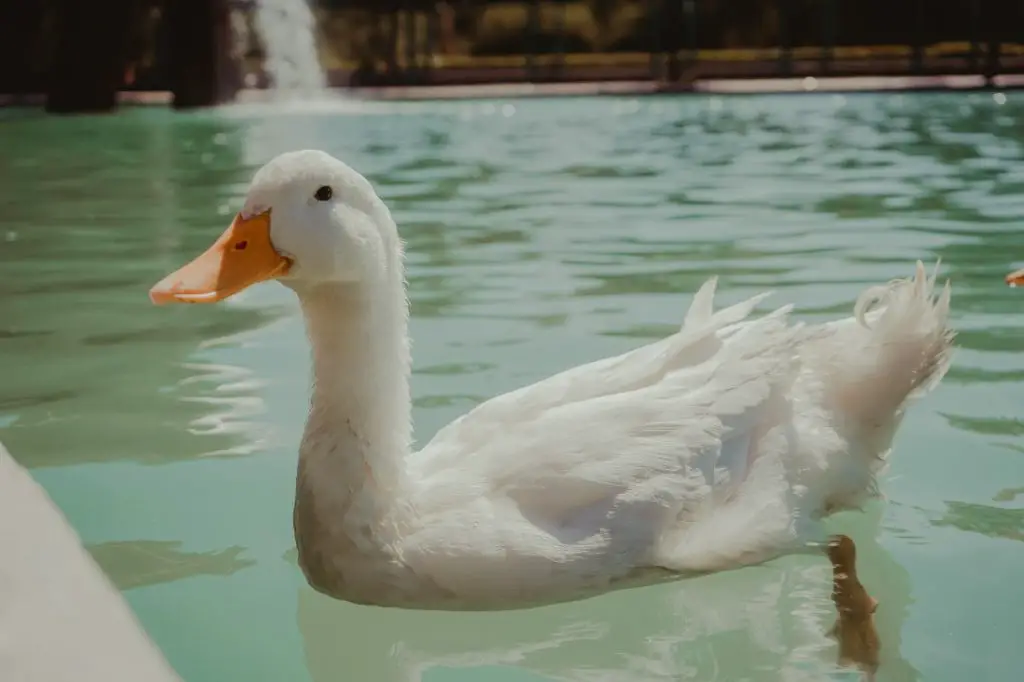Translated by Nick R
Whether you have a couple of ducks or you are planning to have a pen to take advantage of them, it’s important that they have access to plenty of water, not only for drinking but also for bathing and swimming for a while. In this blog you’ll learn some things about their fascination for water, how to make a simple pond, and some alternatives for them.
Table of Contents
How to make a duck pond?
Materials
- Shovel.
- Black plastic.
- PVC pipes or the material you consider for drainage.
- Water filter (Optional).
- Cement.
- Trowel.
- Large ornamental stones or bricks.
Before starting
Remember that the place where the pond is to be built must:
- Be a large place, at least 4 square meters.
- Be a shady place, it should cover a small part of the pond.
- If you’re installing a water filter, you must have close access to an outlet.
- Try to have a hose that reaches the location of the pond.
- Be careful not to damage gas or water pipes in the excavation.
- Have the installation of a septic tank or drain where the water coming out of the pond can reach.
Note: Do not hesitate to ask an expert if you don’t feel knowledgeable enough to make the pond by yourself; they may give you more options.
Steps to make a pond
1. Take measurements of the place where you will make the pond
The pond should not be too big, it will depend a lot on the number of ducks you have and the space you want to give them for swimming; however, keep in mind that each duck needs at least 2 to 3 square meters to do whatever they want to do.
Also, remember to consider the distances for the filter cables, water pump, and drainage, as well as the space that each thing will occupy.
2. Start digging using the shovel
Once the space has been delimited and all the precautionary measures have been taken, you can start digging with a shovel. Bear in mind that the cavity must be at least 1 meter deep so your duck can swim and submerge without any problem.
Remember to leave a steep ramp or ladder so that your ducks can enter and exit the pond easily.
Make sure the shape of the pond is curved to allow the water to flow better.
3. Place the drainage and where the filter will be located
In the same excavation, you must locate at once the places where the filter and the drainage will be, the last one is very important since you must try to give a space where the pipe that will go to the bottom of the pond can pass to drain all the water.
4. Put the plastic in the hole you made
Once you have placed the drainage pipe, cover the entire excavation with plastic and make sure it is well placed in every corner of the pond.
You can flatten the plastic with your feet, but be careful that there are no stones left in the place where you will put it, as they can damage it and allow leaks.
Additionally, remember to make a hole around the drain.
5. Put stones or bricks around it
To support the plastic and give more aesthetics to your pond. You can put ornamental stones or bricks around it, which will also help you avoid that in case of any unevenness in the ground, rainwater reaches the pond and instead surrounds it.
You can cut the excess plastic with scissors or a scalpel.
6. Cover the pond with cement
It is now time to make the cement mixture, I recommend that you follow the directions on the cement to have a good mixture. It must not be too wet so that it can adhere better to the plastic.
Remember to cover the draining hole with newspaper or some element that prevents cement from falling into it.
Once the whole pond is covered with cement, you can sprinkle a little cement and with the help of the wet trowel pass it over the entire surface, this way you can make sure that everything is well covered and avoids leaks.
After drying (depending on the weather and conditions it may take 1 to 2 days), put a plug in the drain with a rope so that when you want to clean it, it will be easier to remove it.
7. Fill with water
Now that you have everything ready you can start filling your pond with water and let your ducks enjoy a good splash. Remember to clean it once every week and a half or two depending on the number of ducks that use it.
Alternatives of space for your ducks to swim in
If making a pond is definitely impossible because of lack of space, you can use other alternatives, remember that what your duck needs most is to be able to dive into the water and cool off, so depending on the size of your duck or the ones you have, it should not be difficult to find other ways to do it, some of them are:
Plastic kiddie pools
This option has certain advantages, such as they come in various sizes, and most of the time they are inexpensive. They are easy to assemble and also to move and clean, they can definitely be of those elements that are not going to cause a major inconvenience in your home for the care of your ducks, however, it may happen that the nails of their paws cause holes in them that end up spoiling it.
Water buckets
As I said, the most important thing for your ducks is that they can have access to water to bathe and clean themselves, in that case, other alternatives that need less space are buckets, which can be shallow enough to fit part of the duck’s body to bathe and shake.
Bathtubs
While the idea of ponds is that they can be fully available to the ducks when they go out to graze, tubs can also be a good way to help your duck cool off, in which you don’t have to fill it with a lot of water, up to half can be enough and let your ducks have fun.
Why ducks must swim?
Ducks are classified as aquatic birds, which means that their morphology has adapted to life in these ecosystems, some of these characteristics are:
- Legs with membranes, which allow them to move better in aquatic environments than terrestrial ones.
- Their flat beak allows them to filter water and capture food found in the water.
- They have a membrane that generates oils, which is located near the duck’s tail and allows the feathers to be waterproof.
You should also keep in mind that swimming in ducks has benefits such as:
- Keep their plumage clean of parasites and healthy since they only molt feathers once a year.
- Clean their beak, nostrils and eyes, besides keeping them in perfect humidity conditions.
- Maintain a good physical and emotional state, avoiding stress and injuries.
- In some cases, some species of ducks are more fertile when they have access to water.
- Bathing helps them regulate their temperature, especially if they live in very hot or tropical places.
How do ducks learn to swim?
Ducks don’t need to be taught to swim, although it’s true that many times the mother’s job is to give them the initiative to jump into the water and start doing it. They’ll do it around the second week after feathering since it is important that their feathers don’t get wet easily and dry quickly with the help of the oils they use to groom themselves.
If you have a duckling and it has reached the time of swimming, don’t hesitate to give it a push to do it, although they won’t hesitate for a moment when they have the opportunity to do it.
Precautions
Although swimming and drinking plenty of water is very common in ducks, you must take some precautions before having a pond in your garden.
Beware of excess humidity
Humidity can be a serious problem in any environment. It can proliferate bacteria, microorganisms, and parasites that can harm your duck even though it is an aquatic bird. It’s important that you prevent excess humidity in their pen or resting place because of these dips.
Make sure their feet stay dry after bathing as well, as there is a risk of hyperkeratosis or necrosis, especially if the water they were in was dirty or on the muddy ground.
Try to keep the pond clean
Make sure the pond doesn’t remain dirty for too long since your ducks will also drink water from it, and they love to have access to water from open places as opposed to what they might have in a drinking fountain.
Another note of the dirt that can accumulate in the pond is that your ducks won’t hesitate for a second to poop there.
Winter Care
Some species of ducks like to swim in winter, although if it’s impossible to keep the pond thawed due to low temperatures, you can use baby pools or buckets in which your bird can submerge its body to bathe.
Conclusions
Ducks should spend 10% of their time in the water, and have easy access to it so they can drink it and digest their food better, so water should not only be in the pond but in other containers such as drinking troughs.
Related Blogs
Keeping a duck as a pet – Complete beginner’s guideHow to breed ducks?


